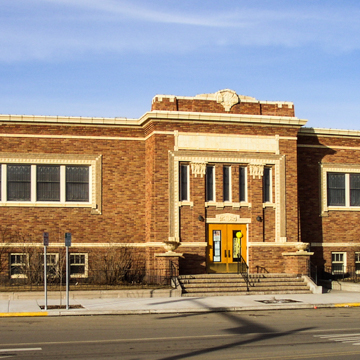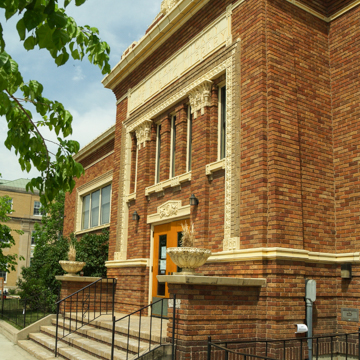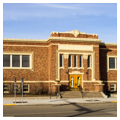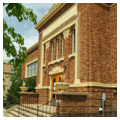Although much has been lost from downtown Jamestown due to fires and demolition, an interesting variety of buildings remains. In terms of its textural details and stylistic exploration, the Alfred Dickey Free Public Library is perhaps the richest building in North Dakota. The Prairie Style was rarely used with this much panache for a public building in the state. The principal impression is the horizontality of the composition, expressed in the central entrance pavilion that is flanked by long rectangular wings, the running bond brickwork, and the bands of stained glass windows. The central pavilion’s entrance is organized around two pilasters with Egyptian-styled terra-cotta capitals and five tall stained glass windows, all of which is surrounded by terra-cotta tile and brickwork, surmounted by a terra-cotta frieze bearing the library’s name, and crowned by a decorative parapet. Terra-cotta ornament also surrounds the windows on the wings. The smooth finish and buff color of the terra-cotta contrast with the rough surface and dark color of the brick walls. An Egyptian motif runs throughout the building, most noticeably on the interior, with the lotus flower being a main component in the ornament. The stained glass features a stylized lotus accented by deep red, green, and amber hues.
This impressive library was funded by and named for North Dakota’s first lieutenant governor, Alfred M. Dickey, and his son, Alfred E. Dickey. Scherer worked briefly with Joseph A. Shannon in Devils Lake at the time Shannon was expanding his architectural market by partnering with the Boyd brothers to build the Jamestown Masonic Lodge. Scherer’s discrete creative influence on Shannon’s architectural work from Devils Lake to Jamestown lasted from about 1915 to 1929, and was terminated by the onset of the Great Depression. One of only a few Prairie Style-influenced buildings attributable to Scherer, the library is one of the most regionally distinctive works of public architecture in the state. Preservation of this important building is endangered by local impulse to relocate the library to a new space without a clear vision of the building’s potential for reuse.





